Go through the Math in Focus Grade 6 Workbook Answer Key Chapter 1 Lesson 1.5 Cubes and Cube Roots to finish your assignments.
Math in Focus Grade 6 Course 1 A Chapter 1 Lesson 1.5 Answer Key Cubes and Cube Roots
Math in Focus Grade 6 Chapter 1 Lesson 1.5 Guided Practice Answer Key
Find a cube of a whole number.
a) A cube has edges 2 centimeters long. Find its volume.
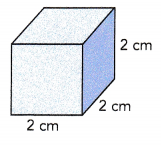
Volume of cube = 2 × 2 × 2 = 8 cm3
2 × 2 × 2 is called the cube of 2.
You can write 2 × 2 × 2 as 23.
So, 23 = 8.
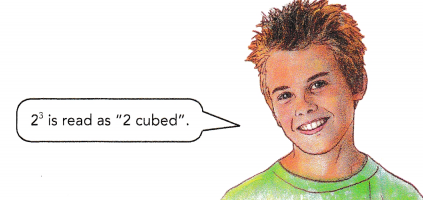
The number 3 in 23 is the exponent. The number 2 is the base.
The cube of a whole number is called a perfect cube.
Since 8 = 2 × 2 × 2, 8 is a perfect cube.
b) Find the cube of 7.
73 = 7 × 7 × 7
= 343
The cube of 7 is 343.

I can relate this to finding the volume of a cube with edges of length 7 units.
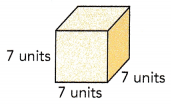
Find the cube of each number.
Question 1.
5
Answer:
125
Explanation:
I can relate this to finding the volume of a cube with edges of length 5 units.
5³ = 5 x 5 x 5
= 125
The cube of 5 is 125.
Question 2.
6
Answer:
216
Explanation:
I can relate this to finding the volume of a cube with edges of length 7 units.
7³ = 7 x 7 x 7
= 216
The cube of 6 is 216.
Question 3.
9
Answer:
729
Explanation:
I can relate this to finding the volume of a cube with edges of length 9 units.
9³ = 9 x 9 x 9
= 729
The cube of 5 is 729.
Find a cube root of a perfect cube.
a) A cube has a volume of 27 cubic meters. Find the length of each edge of the cube.
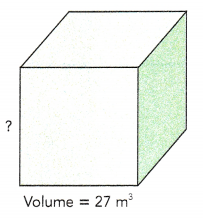
You know that
Volume of cube = edge × edge × edge.
To find the length of the edge of the cube, you need to find a number whose cube is 27.
You know that 3 × 3 × 3 = 27.
So, the length of each edge of the cube is 3 meters. 3 is called the cube root of 27. This can be written as
\(\sqrt[3]{27}\) = 3
Finding the cube root of a number is the inverse of finding the cube of a number.

b) Find the cube root of 64.
By prime factorization,
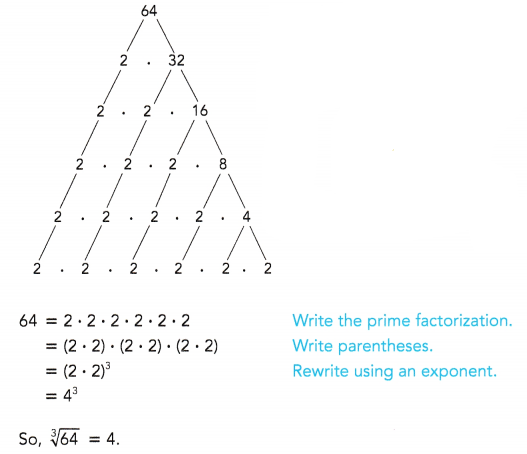
I can relate this to finding the length of an edge of a cube, when I know it has a volume of 64 units3.
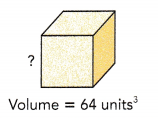

Find the cube root of each number.
Question 4.
216
Answer:
6
Explanation:
Finding the cube root of a number is the inverse of finding the cube of a number
prime factorization of 216 = 2 x 2 x 2 x 3 x 3 x 3
= (2.3)³
=6³
so, cube root of 216 is 6.
Question 5.
343
Answer:
7
Explanation:
Finding the cube root of a number is the inverse of finding the cube of a number
prime factorization of 343 = 7 x 7 x 7
=7³
so, cube root of 343 is 7.
Question 6.
1,000
Answer:
10
Explanation:
Finding the cube root of a number is the inverse of finding the cube of a number
prime factorization of 1000 = 2 x 2 x 2 x 5 x 5 x 5
= (2.5)³
=10³
so, cube root of 1000 is 10.
Complete.
Question 7.
Find the values of 52 + 53 and 5 • 5 • 5 • 5 • 5.
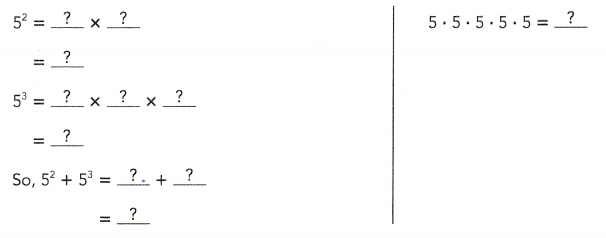
Answer:
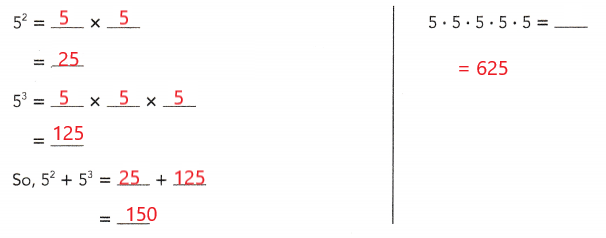
Find the value of each of the following.
Question 8.
63 + 42
Answer:
232
Explanation:
6³ = 6 x 6 x 6= 216
4² = 4 x 4 = 16
6³ + 4² = 216 + 16 = 232
6³ + 4² = 232
Question 9.
73 – 43
Answer:
279
Explanation:
7³ = 7 x 7 x 7 = 343
4³ = 4 x 4 x 4 = 64
7³ – 4³ = 343 – 64 = 279
7³ – 4³ = 279
Question 10.
32 × 53 + 92
Answer:
215
Explanation:
3² = 3 x 3 = 9
5³ = 5 x 5 x 5 = 125
9² = 9 x 9 = 81
3² x 5³ x 9² = 9+125+81 = 215.
3² x 5³ x 9² = 215.
Question 11.
83 ÷ 42 – 52
Answer:
7
Explanation:
8³ = 8 x 8 x 8 = 512
4² = 4 x 4 = 16
5² = 5 x 5 = 25
8³ ÷ 4² – 5² = 512 ÷ 16 – (25)
= 32 – 25
= 7
8³ ÷ 4² – 5² = 7
Question 12.
72 + 63 ÷ 23
Answer:
76
Explanation:
72 = 7 x 7 = 49
6³ = 6 x 6 x 6 = 216
2³ = 2 x 2 x 2 = 8
72 + 63 ÷ 2³ = 49 + (216 ÷ 8)
= 49 + 27
= 76
72 + 63 ÷ 2³ = 76
Question 13.
93 – 42 × 33
Answer:
297
Explanation:
9³ = 9 x 9 x 9 = 729
4² = 4 x 4 = 16
3³ = 3 x 3 x 3 = 27
9³ – 4² + 3³ = 729 – (16 x 27)
= 729 – 432
= 279
9³ – 4² + 3³ = 279.
Math in Focus Course 1A Practice 1.5 Answer Key
Find the cube of each number.
Question 1.
8
Answer:
512
Explanation:
I can relate this to finding the volume of a cube with edges of length 8 units.
8³ = 8 x 8 x 8
= 64 x 8
= 512
The cube of 8 is 512.
Question 2.
3
Answer:
27
Explanation:
I can relate this to finding the volume of a cube with edges of length 3 units.
3³ = 3 x 3 x 3
9 x 3
= 27
The cube of 3 is 27.
Question 3.
10
Answer:
1000
Explanation:
I can relate this to finding the volume of a cube with edges of length 10 units.
10³ = 10 x 10 x 10
=100 x 10
= 1000
The cube of 10 is 1000.
Find the cube root of each number.
Question 4.
125
Answer:
5
Explanation:
Finding the cube root of a number is the inverse of finding the cube of a number
prime factorization of 125 = 5 x 5 x 5
=5³
so, cube root of 125 is 5.
Question 5.
512
Answer:
8
Explanation:
Finding the cube root of a number is the inverse of finding the cube of a number
prime factorization of 512 = 2 x 2 x 2 x 2 x 2 x 2 x 2 x 2 x 2
= (2.2.2)³
=8³
so, cube root of 512 is 8.
Question 6.
729
Answer:
9
Explanation:
Finding the cube root of a number is the inverse of finding the cube of a number
prime factorization of 729 = 3 x 3 x 3 x 3 x 3 x 3
= (3.3)³
=9³
so, cube root of 729 is 9.
Solve.
Question 7.
List the perfect cubes that are between 100 and 600.
Answer:
125, 216, 343 and 512.
Explanation:
125, 216, 343 and 512 are the perfect cubes between 100 and 600.
Question 8.
Math Journal Find the value of each expression. Then describe any patterns you see.
a) 22 – 12
Answer:
3
Explanation:
2² = 2 x 2 = 4
1² = 1 x 1 = 1
2² – 1² = 4 – 1
= 3
2² – 1² = 3.
b) 32 – 22
Answer:
5
Explanation:
3² = 3 x 3 = 9
2² = 2 x 2 = 4
3² – 2² = 9 – 4
= 5
3² – 2² = 5.
c) 42 – 32
Answer:
7
Explanation:
4² = 4 x 4 = 16
3² = 3 x 3 = 9
4² – 3² = 16 – 9
= 7
4² – 3² = 7.
d) 52 – 42
Answer:
9
Explanation:
5² = 5 x 5 = 25
4² = 4 x 4 = 16
5² – 4² = 25 – 16
= 9
5² – 4² = 9.
Question 9.
Find two consecutive numbers whose squares differ by 17.
Answer:
8 and 9
Explanation:
The square of 8 is 64
The square of 9 is 81
81 – 64 = 17
So, 8 and 9 are two consecutive numbers whose squares differ by 17.
Find the value of each of the following.
Question 10.
83 + 52
Answer:
537
Explanation:
8³ = 8 x 8 x 8 = 512
5² = 5 x 5 = 25
8³ + 5² = 512 + 25
= 537
8³ + 5² = 537.
Question 11.
103 – 62
Answer:
964
Explanation:
10³ = 10 x 10 x 10 = 1000
6² = 6 x 6 = 36
10³ – 6² = 1000 – 36
= 964
10³ – 6² = 964.
Question 12.
33 × 92
Answer:
2187
Explanation:
3³ = 3 x 3 x 3 = 27
9² = 9 x 9 = 81
3³ x 9² = 27 x 81
= 2187
3³ x 9² = 2187
Question 13.
93 – 52 + 62
Answer:
740
Explanation:
9³ = 9 x 9 x 9 = 729
5² = 5 x 5 = 25
6² = 6 x 6 = 36
9³ – 5² + 6² = 729 – 25 + 36
= 740
9³ – 5² + 6² = 740.
Question 14.
72 + 83 – 42
Answer:
545
Explanation:
7² = 7 x 7 = 49
8³ = 8 x 8 x 8 = 512
4² = 4 x 4 = 16
72 + 83 – 4² = 49 + 512 – 16
= 545
72 + 83 – 4² = 545
Question 15.
93 – 52 + 62
Answer:
740
Explanation:
9³ = 9 x 9 x 9 = 729
5² = 5 x 5 = 25
6² = 6 x 6 = 36
93 – 52 + 6² = 729 – 25 + 36
= 740
93 – 52 + 6² = 740
Question 16.
83 × 53 ÷ 52
Answer:
2560
Explanation:
8³ = 8 x 8 x 8 = 512
53 = 5 x 5 x 5 = 125
5² = 5 x 5 = 25
8³ × 53 ÷ 5² = 512 x 125 ÷ 25
= 2560
8³ × 53 ÷ 5² = 2560
Question 17.
103 ÷ 82 × 42
Answer:
250
Explanation:
10³ = 10 x 10 x 10 = 1000
8² = 8 x 8 = 64
4² = 4 x 4 = 16
10³ ÷ 8² x 4² = 1000 ÷ 64 x 16
= 250
10³ ÷ 8² x 4² = 250.
Question 18.
73 – 102 ÷ 22
Answer:
318
Explanation:
7³ = 7 x 7 x 7 = 343
10² = 10 x 10 = 100
2² = 2 x 2 = 4
7³ – 10² ÷ 2² = 343 – (100 ÷ 4 )
= 343 – 25
= 318
7³ – 10² ÷ 2² = 318
Question 19.
33 + 43 × 62
Answer:
2331
Explanation:
3³ = 3 x 3 x 3= 27
4³ = 4 x 4 x 4 = 64
6² = 6 x 6 = 36
33 + 43 × 6² = 27 + (64 x 36 )
= 27 + 2304
= 2331
33 + 43 × 6² = 2331.
Find the value of each of the following.
Question 20.
173
Answer:
4913
Explanation:
I can relate this to finding the volume of a cube with edges of length 17 units.
17³ = 17 x 17 x 17
= 289 x 17
= 4913
The cube of 17 is 4913.
Question 21.
163
Answer:
4096
Explanation:
I can relate this to finding the volume of a cube with edges of length 16 units.
16³ = 16 x 16 x 16
= 256 x 16
= 4096
The cube of 16 is 4096.
Question 22.
183
Answer:
5832
Explanation:
I can relate this to finding the volume of a cube with edges of length 18 units.
18³ = 18 x 18 x 18
= 324 x 18
= 5832
The cube of 18 is 5832.
Question 23.
![]()
Answer:
12
Explanation:
Finding the cube root of a number is the inverse of finding the cube of a number
prime factorization of 1728 = 2 x 2x 2 x 2 x 2 x 2 x 3 x 3 x 3
= (2.2.3)³
=12³
So, cube root of 1728 is 12.
Question 24.
![]()
Answer:
20
Explanation:
Finding the cube root of a number is the inverse of finding the cube of a number
prime factorization of 8000 = 2 x 2 x 2 x 2 x 2 x 2 x 5 x 5 x 5
= (2.2.5)³
=20³
So, cube root of 8000 is 20.
Question 25.
![]()
Answer:
15
Explanation:
Finding the cube root of a number is the inverse of finding the cube of a number
prime factorization of 3375 = 3 x 3 x 3 x 5 x 5 x 5
= (3.5)³
=15³
So, cube root of 3375 is 15.
Solve.
Question 26.
Given that 113 = 1,331, find the cube of 110.
Answer:
1,331,000
Explanation:
If 113 = 1,331 then 110³ will be 1,331,000.
Question 27.
Given that 143 = 2,744, find the cube root of 2,744,000.
Answer:
140³
Explanation:
If 14³ = 2,744 then cube root of 2,744,000 is 140³.
Question 28.
Given that ![]() = 16, evaluate 1603.
= 16, evaluate 1603.
Answer:
4,096,000
Explanation:
If cube root 4096 is 16 then 160³ will be 4,906,000.
Question 29.
Evaluate 132 + 203 – 182.
Answer:
7845
Explanation:
13² = 13 x 13 = 169
20³ = 20 x 20 x 20 = 8000
18² = 18 x 18 = 324
132 + 203 – 18² = 169 + 8000 – 324
= 7845
132 + 203 – 18² = 7845.
Question 30.
Evaluate the cube root of 123 × 53 + 8³.
Answer:
68
Explanation:
Cube root of 123 × 53 + 8³ will be the number itself
So, 12 x 5 + 8 = 68 is cube root of 123 × 53 + 8³.
Question 31.
Find three consecutive numbers whose cubes have a sum of 2,241.
Answer:
8, 9, 10
Explanation:
8³ = 512
9³ = 729
10³ = 1000
512 + 729 + 1000 = 2241
So, the three consecutive numbers whose cubes have a sum of 2241 are 8, 9 and 10.
Question 32.
A cubic crate with an edge length of 16 feet will be used to contain cubic wooden boxes. Each wooden box has an edge length of 4 feet. How many wooden boxes can the crate contain?
Answer:
4 wooden boxes
Explanation:
A cubic crate with an edge length of 16 feet will be used to contain cubic wooden boxes.
Each wooden box has an edge length of 4 feet
4 x 4 = 16
S0, the wooden crate can contain 4 wooden boxes.
Brain @ Work
Mr. Henderson wants to tile his patio that is rectangular in shape. His patio measures 108 inches by 144 inches. Find the fewest square tiles he can use without cutting any of them. (Hint: First find the largest size tile he can use.)
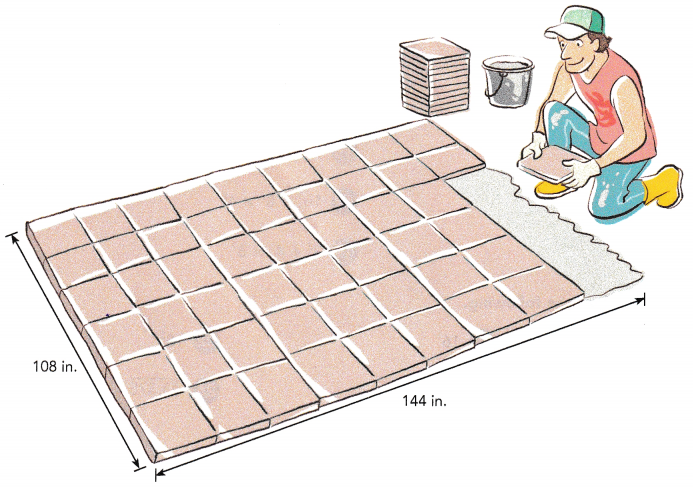
Answer:
21 tiles of 12 inches square tile
Explanation:
Mr. Henderson wants to tile his patio that is rectangular in shape.
His patio measures 108 inches by 144 inches
The largest size tile he can use is 12 inches
12 in x 12 tiles = 144 in
12 in x 9 tiles = 108 in
So, Mr. Henderson wants 21 tiles of 12 inches to tile his patio in rectangular shape without cutting any square tile.